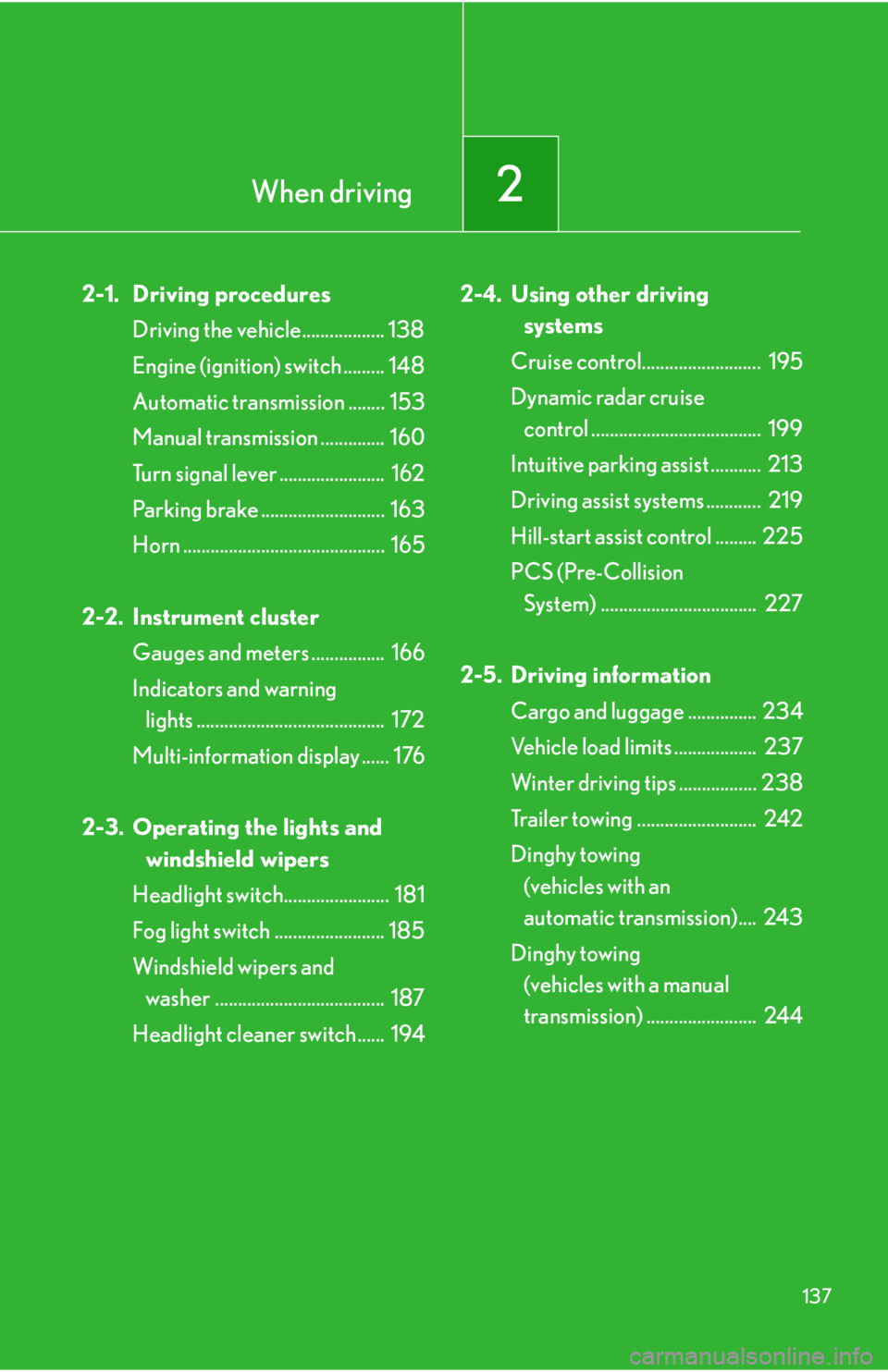warning Lexus IS250C 2012 Instrument cluster / LEXUS 2012 IS250C,IS350C (OM53A62U) User Guide
[x] Cancel search | Manufacturer: LEXUS, Model Year: 2012, Model line: IS250C, Model: Lexus IS250C 2012Pages: 632, PDF Size: 6.77 MB
Page 107 of 632

107
1-7. Safety information
1
Before driving
Airbag system componentsYour vehicle is equipped with AD VANCED AIRBAGS designed based
on US motor vehicle sa fety standards (FMVSS208). The airbag system
controls airbag deployment power for the driver and front passenger. The
driver airbag system consists of the driver seat’s position sensor etc. The
front passenger’s airbag system con sists of the front passenger occupant
classification sensor etc.
The main SRS airbag system componen ts are shown above. The SRS air-
bag system is controlled by the airb ag sensor assembly. The airbag sen-
sor assembly consists of a safing sensor and an airbag sensor.
Knee airbags
Front passenger airbag
“AIR BAG ON” and “AIR BAG
OFF” indicator lights
Side airbags
Side airbag sensors
SRS warning light
Driver airbag
Driver's seat belt buckle switch
Driver's seat position sensor
Front passenger’s seat belt
buckle switch
Airbag sensor assembly
Occupant detection system
(ECU and sensors)
Front airbag sensors
Page 109 of 632

109
1-7. Safety information
1
Before driving
■SRS warning light
This warning light system monitors the airbag sensor assembly, front airbag sensors,
side airbag sensor assemblies , driver's seat position sensor, driver's seat belt buckle
switch, seat belt pretensioner assemblies, inflators, interconnecting wiring and
power sources. ( P. 4 9 6 )
■If the SRS airbags deploy (inflate)
●Bruising and slight abrasions may result from contact with a deploying (inflating)
SRS airbag.
●A loud noise and white powder will be emitted.
●Parts of the airbag module (steering wheel , airbag cover and inflator) as well as
the front seats may be hot for several minu tes. The airbag itself may also be hot.
●The windshield may crack.
●For Safety Connect subscribers, if the SRS airbags deploy or in the event of a
severe rear-end collision, the system is designed to send an emergency call to
the response center, notifying them of the vehicle’s location (without needing to
push the “SOS” button) and an agent will attempt to speak with the occupants
to ascertain the level of emergency and assistance required. If the occupants
are unable to communicate, the agent automatically treats the call as an emer-
gency and helps to dispatch the necessary emergency services. ( P. 3 9 4 )
■SRS airbag deployment conditions (SRS front airbags)
●The SRS front airbags will deploy in the event of an impact that exceeds the
set threshold level (the level of force corresponding to an approximately 12 -
18 mph [20 - 30 km/h] frontal collision with a fixed wall that does not move or
deform).
However, this threshold velocity will be considerably higher if the vehicle strikes
an object, such as a parked vehicle or sign pole, which can move or deform on
impact, or if the vehicle is involved in an underride collision (e.g. a collision in
which the front of the vehicle “underrides”, or goes under, the bed of a truck, etc.).
●It is possible that in some collisions where the forward deceleration of the vehi-
cle is very close to the designed thresh old level, the SRS front airbags and the
seat belt pretensioners ma y not activate together.
●The SRS front passenger airbag will not activate if there is no passenger sitting
in the front passenger seat. However, the front passenger airbag may deploy if
luggage is put in the seat, or the seat belt is fastened, even if the seat is unoccu-
pied. ( P. 1 1 8 )
Page 118 of 632

118
1-7. Safety information
Front passenger occupant classification system
Your vehicle is equipped with a front passenger occupant classification sys-
tem. This system detects the conditions of the front passenger seat and
activates or deactivates the devices for front passenger.
SRS warning light
“AIR BAG OFF” indicator light
“AIR BAG ON” indicator light
Front passenger’s seat belt reminder light
Page 119 of 632

119
1-7. Safety information
1
Before driving
Condition and operation in the front passenger occupant classification system
■Adult*1
■Child *3 or child restraint system*4
Indicator/
warning light “AIR BAG ON” and “AIR BAG OFF”
indicator lights “A I R B A G
ON”
SRS warning light Off
Front passenger’s seat belt reminder light Flashing
*2
DevicesFront passenger airbag
Activated
Side airbag on the front
passenger seat
Front passenger knee airbag
Front passenger’s seat belt pretensioner
Indicator/
warning light “AIR BAG ON” and “AIR BAG OFF”
indicator lights “A I R B A G
OFF”
*5
SRS warning light Off
Front passenger’s seat belt reminder light Flashing
*2
DevicesFront passenger airbag
Deactivated
Side airbag on the front
passenger seat
Front passenger knee airbag
Front passenger’s seat belt pretensioner Activated
Page 120 of 632

120
1-7. Safety information
■Unoccupied
■ There is a malfunction in the system
*
1: The system judges a person of adult size as an adult. When a smaller adult sits in the front passenger seat, the system may recognize him/
her as a child depending on his/her physique and posture.
*
2: In the event the front passenger does not wear a seat belt.
*
3: When a larger child who has outgrow n a child restraint system sits in
the front passenger seat, the system may recognize him/her as an
adult depending on his/her physique or posture.
Indicator/
warning light “AIR BAG ON” and “AIR BAG OFF”
indicator lightsNot illuminated
SRS warning light Off
Front passenger’s seat belt reminder light
Devices Front passenger airbag
Deactivated
Side airbag on the front
passenger seat
Front passenger knee airbag
Front passenger’s seat belt pretensioner
Indicator/
warning light “AIR BAG ON” and “AIR BAG OFF”
indicator lights “A I R B A G
OFF”
SRS warning light On
Front passenger’s seat belt reminder light Off
Devices Front passenger airbag
Deactivated
Side airbag on the front
passenger seat
Front passenger knee airbag
Front passenger’s seat belt pretensioner Activated
Page 122 of 632

122
1-7. Safety information
CAUTION
■Front passenger occupant classification system precautions
●Do not recline the front passenger seatback so far that it touches a rear seat. This
may cause the “AIR BAG OFF” indicator ligh t to be illuminated, which indicates
that the passenger’s airbags will not deploy in the event of a severe accident. If the
seatback touches the rear se at, return the seatback to a position where it does
not touch the rear seat. Keep the front pa ssenger seatback as upright as possible
when the vehicle is moving. Reclining the seatback excessively may lessen the
effectiveness of the seat belt system.
●If an adult sits in the front passenger se at, the “AIR BAG ON” indicator light is illu-
minated. If the “AIR BAG OFF” indicator is illuminated, ask the passenger to sit
up straight, well back in the seat, feet on the floor, and with the seat belt worn cor-
rectly. If the “AIR BAG OFF” indicator still remains illuminated, either ask the pas-
senger to move to the rear seat, or if th at is not possible, move the front passenger
seat fully rearward.
●When it is unavoidable to install the forward facing child restraint system on the
front passenger seat, install the child rest raint system on the front passenger seat
in the proper order. ( P. 1 2 7 )
●Do not modify or remove the front seats.
●Do not kick the front passenger seat or subject it to severe impact. Otherwise,
the SRS warning light may come on to indicate a malfunction of the detection sys-
tem. In this case, contact your Lexus dealer immediately.
●Child restraint systems installed on the rear seat should not contact the front seat-
backs.
●Do not use a seat accessory, such as a cushion or seat cover, that covers the seat
cushion surface.
●Do not modify or replace the upholstery of the front seat.
Page 137 of 632

When driving2
137
2-1. Driving proceduresDriving the vehicle.................. 138
Engine (ignition) switch ......... 148
Automatic transmission ........ 153
Manual transmission .............. 160
Turn signal lever ....................... 162
Parking brake ........................... 163
Horn ............................................ 165
2-2. Instrument cluster Gauges and meters ................ 166
Indicators and warning lights ......................................... 172
Multi-information display ...... 176
2-3. Operating the lights and windshield wipers
Headlight switch....................... 181
Fog light switch ........................ 185
Windshield wipers and washer ..................................... 187
Headlight cleaner switch...... 194 2-4. Using other driving
systems
Cruise control.......................... 195
Dynamic radar cruise control ..................................... 199
Intuitive parking assist ........... 213
Driving assist systems ............ 219
Hill-start assist control ......... 225
PCS (Pre-Collision System) .................................. 227
2-5. Driving information Cargo and luggage ............... 234
Vehicle load limits .................. 237
Winter driving tips ................. 238
Trailer towing .......................... 242
Dinghy towing (vehicles with an
automatic transmission).... 243
Dinghy towing (vehicles with a manual
transmission) ........................ 244
Page 158 of 632

158
2-1. Driving procedures
■When the “-” shift paddle switch is operated in the D position
When the “-” shift paddle switch is operated in the D position, a shift range will be
automatically selected. The highest gear of the first shift range will be one gear
lower than the gear in use during normal D position driving.
■Automatic deactivated of shift range selection in the D position
Shift range selection in the D position will be deactivated in the following situations:
●When the vehicle comes to a stop
●When range 6 is selected and the accelerator pedal is depressed
●If the accelerator pedal is depressed for more than a certain period of time
■To protect automatic transmission
A function is adopted that automatically se lects a higher shift range when the fluid
temperature is high.
■Gear position disp lay when driving
The current gear is displayed on the multi-information display. ( P. 1 7 9 )
■Downshifting restrictions warning buzzer
To help ensure safety and driving perfor mance, downshifting operation may some-
times be restricted. In some circumstance s, downshifting may not be possible even
when the shift lever or shift paddle switch is operated. (The warning buzzer will
sound twice.)
■When driving with the cruise control syst em or dynamic radar cruise control sys-
tem
Engine braking will not occur during shif t range selection in the D position or S
mode, even when downshifting to range 5 or 4. ( P. 195, 199)
■Snow mode automatic deactivation
Snow mode is automatically deactivated if the “ENGINE START STOP” switch is
turned off after driving in snow mode.
■If the shift lever cannot be shifted from P
P. 5 3 1
Page 172 of 632

172
2-2. Instrument cluster
Indicators and warning lights
The indicator and warning lights on the instrument cluster and center
panel inform the driver of the status of the vehicle’s various systems.
Instrument cluster
The units used on the speedometer and the tachometer gauge display may
differ depending on the model/type.
Center panel
Page 174 of 632

174
2-2. Instrument cluster
*1: These lights turn on when the “ENGINE START STOP” switch isturned to IGNITION ON mode to indicate that a system check is
being performed. They will turn off after the engine is started, or after a
few seconds. There may be a malfunction in a system if a light does not
come on, or if the lights do not turn off. Have the vehicle inspected by
your Lexus dealer.
*2: The light flashes to indicate that the system is operating.
■ Warning lights
Warning lights inform the driver of malfunctions in any of the vehi-
cle’s systems. ( P. 495)
*: These lights turn on when the “ENGINE START STOP” switch is turned
to IGNITION ON mode to indicate that a system check is being per-
formed. They will turn off after the en gine is started, or after a few sec-
onds. There may be a malfunction in a system if a light does not come on,
or if the lights do not turn off. Have the vehicle inspected by your Lexus
dealer.
(U.S.A.)(Canada)(U.S.A.)(Canada)
(U.S.A.)(Canada)(if equipped)(for
driver)(for front
passen-
ger)
******
******
*